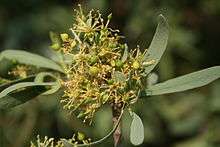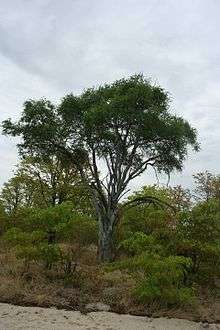Boscia albitrunca
| Shepherd tree | |
|---|---|
 | |
 | |
| Scientific classification | |
| Kingdom: | Plantae |
| (unranked): | Angiosperms |
| (unranked): | Eudicots |
| (unranked): | Rosids |
| Order: | Brassicales |
| Family: | Capparaceae |
| Genus: | Boscia |
| Species: | B. albitrunca |
| Binomial name | |
| Boscia albitrunca (Burch.) Gilg & Ben. | |
Boscia albitrunca, commonly known as the Shepherd tree or Shepherd's tree (Afrikaans: Witgat, Sotho: Mohlôpi, Tswana: Motlôpi, Venda: Muvhombwe, Xhosa: Umgqomogqomo, Zulu: Umvithi), is a protected tree in South Africa.[1] The species epithet "albitrunca" refers to the oftentimes white trunk. It is an evergreen tree native to southern and tropical Africa, living in the hot, dry, and often brackish low-lying areas, sometimes on abundant lime or occasionally found in rocky terrain. It is a common tree of the Kalahari, bushveld and lowveld. It is one of the most important forage trees in the Kalahari.[2]

Description
This tree grows up to 10 m (33 ft) tall but is usually much smaller. It has a prominent, sturdy white trunk frequently with strips of rough, dark-coloured bark. The crown is often browsed by antelope and all grazers that can reach the foliage, resulting in a conspicuous flattened underside or browse-line. The leaves are narrow, oblanceolate, and stiff with veins obscure except for the distinct midrib. The flowers are small, greenish-yellow, star-shaped, and clustered. The fruits, on a jointed stalk, are about 10 mm (0.4 in) in diameter and are brittle-skinned with a whitish flesh and large endocarp. A specimen found in the central Kalahari in 1974 had roots extending to 68 m (223 ft) deep, making it the plant with the deepest known roots.[3]
Relationships
Boscia belongs to the caper family Capparaceae. Pickled capers are made from the unopened buds of European members of this family. Boscia albitrunca is closely related to Boscia foetida subsp. rehmanniana, which has much smaller leaves and velvet-textured fruits. The genus was named for Louis Bosc (1759-1828), a French professor of agriculture who lived through the revolution.
See also
References
- ↑ "Protected Trees" (PDF). Department of Water Affairs and Forestry, Republic of South Africa. 3 May 2013. Archived from the original (PDF) on 2010-07-05.
- ↑ Havenga, C. J.; van Niekerk, W. A.; Rethman, N. F. G.; Coertze, R. J. (2004). "Certain qualitative characteristics of Boscia foetida at different sites in South Africa" (PDF). South African Journal of Animal Science (34): 62–64. Retrieved 18 May 2016.
- ↑ Canadell, J.; R. B. Jackson; J. B. Ehleringer; H. A. Mooney; O. E. Sala; E.-D. Schulze (December 3, 2004). "Maximum rooting depth of vegetation types at the global scale". Oecologia. 108 (4): 583–595. doi:10.1007/BF00329030.
- "Boscia albitrunca". Plantz Afrika. Retrieved 2010-03-04.
External links
- Dressler, S.; Schmidt, M. & Zizka, G. (2014). [http://www.africanplants.senckenberg.de/root/index.php?submitForm=true&page_id=77&searchTextMenue=Boscia+albitrunca&filterRegionIDs[]=6&filterRegionIDs[]=1&filterRegionIDs[]=2&filterRegionIDs[]=3&filterRegionIDs[]=5 "Boscia albitrunca"]. African plants – a Photo Guide. Frankfurt/Main: Forschungsinstitut Senckenberg.